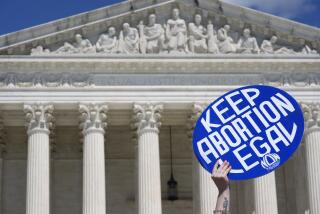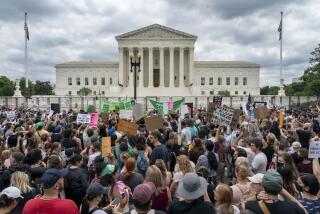Researchers find increase in double mastectomies
- Share via
The number of women having both breasts removed after a tumor is found in one increased by 150% over a five-year period, despite a lack of evidence that double mastectomies increase survival in most women, researchers reported Monday.
Current guidelines for treatment of a localized breast cancer call only for removal of the tumor and not for a mastectomy, much less a double mastectomy.
But an increasing number of women, particularly young white women, are pushing for the more aggressive procedure for reasons that are not clear, the researchers said.
Some women, researchers surmise, believe that the healthcare system did not detect their tumors early enough and that continued screening would not be effective, and others might have been traumatized by chemotherapy. Improvements in reconstructive surgery have also made a double mastectomy a more acceptable alternative.
“If they are making this decision based on fear, and thinking that it will increase their survival, then that would concern me,” said Dr. Julie Gralow, an associate professor at the University of Washington and a spokeswoman for the American Society of Clinical Oncology.
“But if they understand that it won’t necessarily improve their survival and that emotionally it is the best thing for them, then we would have to support it,” said Gralow, who was not involved in the study.
Dr. I. Benjamin Paz of the City of Hope Comprehensive Cancer Center in Duarte, however, finds the trend “alarming, because the goal of medicine is to help people live well with their organs.”
Paz, who was also not involved in the study, attributes the trend in large part to the increasing use of MRI imaging, which reveals many small lesions in breasts that weren’t observed before.
“A woman goes through this and she feels that [the cancer] is spreading all over,” he said. “It is very difficult to explain to such a woman that she can be treated with breast conservation.”
An estimated 178,480 women will be diagnosed with breast cancer this year, according to the American Cancer Society, and about 40,460 will die of it.
Dr. Todd M. Tuttle of the University of Minnesota Medical School and his colleagues decided to perform the study because they had noticed an increasing incidence of double mastectomies but could find no data about their frequency.
The researchers used data from the federal government’s Surveillance, Epidemiology and End Results cancer registry, which included information from 16 regions that represent about 26% of the country.
They identified 152,755 patients with cancer in a single breast from 1998 to 2003, the latest period for which data are available.
They reported in the Journal of Clinical Oncology that over the five-year period, 57.8% of women who received surgery underwent breast-conserving surgery, also known as a lumpectomy, and 38.9% had a unilateral mastectomy.
Overall, the rate of double mastectomies rose to 4.5% in 2003 from 1.8% in 1998. Among women having a mastectomy, the proportion having the second breast removed prophylactically rose to 11% in 2003 from 4.2% in 1998.
“Some women are so traumatized by having a breast cancer, especially if it is not found early, that they have a lack of trust in the whole system of finding the next one early,” said Dr. Christy A. Russell of USC’s Keck School of Medicine, who was not involved in the study. “It seems easier to remove everything and not have to deal with mammography screening anymore.”
Gralow said that in her practice, the type of patient choosing a double mastectomy “is very well educated, has researched all her options and is making this decision very thoughtfully. In fact, a couple of our faculty members have chosen it.”
Her main goal, she added, “is to make sure they weren’t reacting in a panic mode from the scare of a diagnosis of cancer.”
Paz and Russell said they spent a great deal of time counseling patients about the potential problems and benefits of double mastectomies.
“The breast is a sexual organ, and they need to understand the implications of having both removed, in terms not only of physical appearance, but also of their sex life and sexuality,” Russell said.
“And what is not being said in this paper is the cost of all this,” Paz said. A mastectomy and the reconstruction of the second breast costs $10,000 to $30,000, he estimated. “The cost to society is very significant.”






